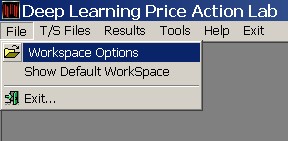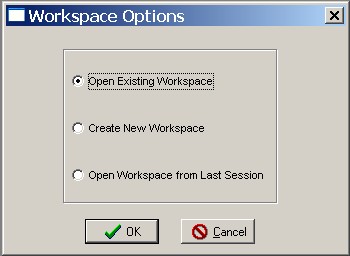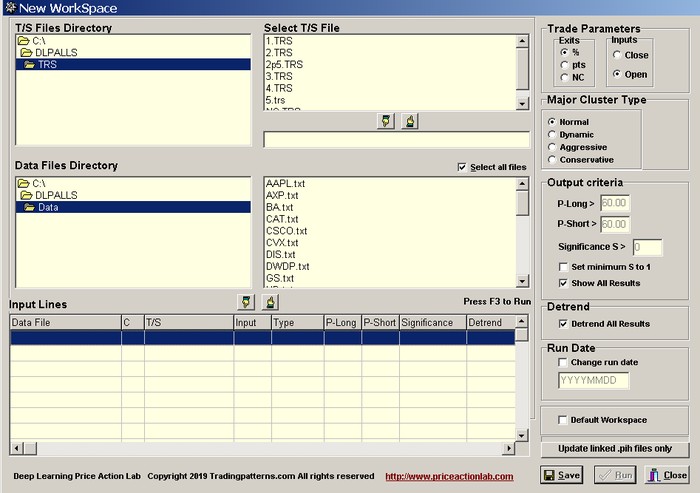To open an existing workspace or create a new one
Click File and then click Workspace.

Select Open Existing Workspace and then click OK. Select a file and then click Open.

To Create a new workspace
Click File, then Workspace, select Create New Workspace and click OK. Then, click on the first empty scan line to start the process of parameter selection.

The following must be specified on the workspace form for each separate search line:
1. T/S file
2. Data file(s)
3. Trade parameters: Exits based on percentages (%) of entry price, points (pts) added to entry price or Next Close (NC). Trade Inputs are the Open or Close
4. Major Cluster Type: Choice between aggressive and normal
5. Output criteria: Results can be filtered by minimum P-long, minimum P-short and minimum Significance S. Alternatively, all results will be shown by checking Show All Results box.
6. Detrending option: If the option is marked the results will be adjusted for the presence of a trend based on a proprietary algorithm
To Select a T/S file
Select a T/S file from the appropriate directory. Click on a file to highlight it and then click the hand icon pointing down to move it in the selection field. Alternatively, you can just double-click a file and it will automatically get selected. To change the T/S file click the hand icon pointing up and repeat the selection process. Note: In the case that next close (NC) is selected as the exit parameter, a dummy T/S file must be selected with just one pair of target/stop values but these will not be used by the program.
To Select data file(s)
Select the directory where the data files are located and mark the box next to the option Select all files, to select all files in the directory specified (default option). If this option is checked, the same T/S file, Trade Parameters Major Cluster Type, Output Criteria and Detrend Option will apply to all data files. Note: To select a single file from a directory you must first uncheck the box next to the Select all files option and then highlight the file.
Trade Parameters
Specify the type of exits (percent or points) to be used with the profit target and stop-loss values in the T/S file, or next close (NC), by selecting % for percentages of entry price, pts for points added to entry price, or NC for next close exit. Specify the type of trade input by selecting either Open or Close. If Open is selected then the entry price will be the open of the next bar. If Close is specified, then the entry price will be the close.
Major Cluster Type
Aggressive cluster has 5 sub-clusters. Normal has 10 sub-clusters. Dynamics has 7 sub-clusters and Conservative has 15 sub-clusters Note that the more features that are involved in the extraction of features, the more conservative the results because more market conditions are taken into account. The Normal cluster is the most popular and robust.
Output Criteria
The results can be initially filtered by minimum P-long, minimum P-short and minimum Significance S. Alternatively, all results will be shown by checking the Show All Results box. P-long and P-short values range is from 0 to 100. Values above 60 may indicate a good directional bias when the value of Significance S is greater than 3.
The minimum significance S in results can be set to 1. This is useful in the case of limited samples or slower timeframes, such as weekly. The default setting is to keep original values and this is recommended. Note: if the option is used it is not saved in the workspace and must be entered manually each time it is retrieved.
Detrend option
If the option is marked (default choice) the results will be adjusted for the presence of a trend based on a proprietary algorithm.
Run Date
The default run date each time the program runs is the last date of each data file. You can specify a different run date by first marking the appropriate box and then inputting the date in YYYYMMDD format. Note: if the run date specified does not exist but it is inside the data file date range the calculations will be made based on the previous date. For example, if the run date falls on a Saturday, the previous Friday’s data will be used for last date for each file. If the date range is outside the date range, then the last date in the data file will be used. The user is responsible for specifying the proper Run Date.
Default workspace
You may mark a workspace as the default workspace of the program by checking the box next to Default workspace.
A default workspace will load automatically when the program is first executed if the Show Default Workspace option in the main program menu is checked, as shown below:
To create a new input line, click on the first empty scan line. After the file and parameter selections, click on the hand icon pointing downwards. To delete a line, click on that line and hit the DEL key, or use the hand icon pointing upwards to remove its contents.
Saving the workspace and Running for results
Click Save to save the workspace. Click Run or hit the F3 key to run the workspace.
Update linked pih files only
Click “Update linked .pih files only” to update .pih files that correspond to text files in each input line of the workspace. For the update to work the .pih files must be located in same directory and each line of the workspace must correspond to a single .txt file. The .pih files must already exist. “Select all files” is not allowed on any workspace input lines with this update option. This tool is useful for updating .pih files that use different parameters. The .pih files may be created one-by-one using “Create feature history” from Tools. That tool can update only .pih files that use same parameters.
Below is an example of a workspace with single .txt file sin each input line and different parameters that is valid for .pih update using this tool:
If there is a need to create train and score files, those may be generated using “Create Train/Score” from “Create feature history” tool and by specifying the common directory of the .pih files. Any T/S file may be used because it is not used for generation of train/score files. Same tool may be used to rebuild or delete those files.










